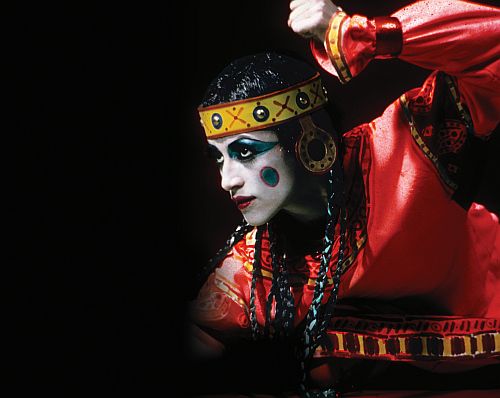 United States Adams, Pärt, Stravinsky: Soloists, Joffrey Ballet, Scott Speck (conductor), Dorothy Chandler Pavilion, Los Angeles, 1.2.2013-3.2.2013 (JRo)
United States Adams, Pärt, Stravinsky: Soloists, Joffrey Ballet, Scott Speck (conductor), Dorothy Chandler Pavilion, Los Angeles, 1.2.2013-3.2.2013 (JRo)
Stanton Welch: Son of Chamber Symphony with music by John Adams
Christopher Wheeldon: After the Rain with music by Arvo Pärt
Vaslav Nijinsky: Le Sacre du Printemps (Reconstructed by Millicent Hodson and Kenneth Archer)

It’s hard to believe that one hundred years have passed since Igor Stravinsky, Vaslav Nijinsky, and the Ballets Russes premiered Le Sacre du Printemps. As famously reconstructed in the 1980s by Millicent Hodson and Kenneth Archer (under the artistic supervision of Robert Joffrey) and in performance at the Dorothy Chandler Pavilion in Los Angeles through February 3, The Rite of Spring remains startlingly modern and vivid – a breathtaking evocation of pre-Christian Slavic man – still working its magic in the twenty-first century.
Dance and music lovers are well aware of the notorious 1913 premiere in Paris, which branded Rite as one of the most controversial and important works of art of any century. The music, with its complex rhythms and pounding dissonances, and the choreography, the antithesis of classical ballet with its hunched postures, bent arms, and turned-in feet, enraged the audience, eliciting boos and fistfights in the aisles. By most accounts, Stravinsky was in despair. Diaghilev, however, was delighted with the scandal, while poor Nijinsky had to count out the rhythms over the roar of the jeering crowd because the dancers were unable to hear the music.
Thanks to Archer and Hodson’s exhaustive research, not only does the stage come alive with Nijinsky’s genius, but also with Nicholas Roerich’s sparkling backdrops and costumes. An archaeologist, folklorist, and painter, Roerich worked closely with Stravinsky on the scenario for the ballet. The result was the perfect marriage of music, visual art, and dance, and it stands at the summit of artistic achievement.
Under the baton of the Joffrey Ballet’s music director, Scott Speck, the orchestra, composed mainly of LA Opera musicians, did full credit to Stravinsky’s iconic score. First, the plaintive bassoon wove its spell, and then, as other instruments joined in, the curtain rose on Roerich’s verdant landscape. As the insistent pulse of the music gained momentum, the dancers, dressed in white, red, and ochre, began the foot stomping choreography that so enraged Parisian audiences. The men, crouched and bent, exploded into motion, their movements emanating from their hips and stomachs; the women raced in with their legs flying and then quickly reverted to flat feet with toes turned inward, their heads slanted on necks like rag dolls. As I watched Act I, “The Adoration of the Earth,” unfold, I felt as if I were witnessing early man’s encounter with the mysteries of existence.

Act II, “The Sacrifice,” features a circle of young girls trudging counter-clockwise in a fatal march towards destiny. As the music grows ominous, the sacrificial maiden, dubbed “The Chosen One,” is forced into the center of the circle. Men dressed in bearskins lumber onto the stage and surround her, pawing the earth with their feet like feral creatures. In a bravura performance, Erica Lynette Edwards danced an uncanny range of emotions, cycling from fear to supplication to anger, her body bursting into bent knee jumps, her hands chopping air, her arms flailing, her fists pounding the earth. With her knees shaking in terror, she spasmed into violent arcs and mad spinning – a dance to exhaustion and imminent death.
If the measure of a ballerina’s dramatic abilities in the nineteenth-century repertory is Giselle and her mad scene, then surely the twentieth century standard should be the agonized terror of “The Chosen One.” Here we have a ballet for all time, a moment when sophisticated Western civilization meets the roots of man’s consciousness.
Opening the evening was Stanton Welch’s Son of Chamber Symphony with music by John Adams, followed by Christopher Wheeldon’s After the Rain with music by Arvo Pärt from Tabula Rasa and Spiegel im Spiegel. Both dances were an intelligent pairing with The Rite of Spring,bringing the radical artistic lessons of the past into the minimalist present.
Adams’ winning score for Son of Chamber Symphony was securely handled by the orchestra. The ballet displayed the beauty of classical dance coupled with the geometric abstraction of bodies in space, defined by the elegant lines of legs and arms and the sharply spherical tutus that bounced and swayed, taking on a life of their own.
After the Rain was mesmerizing, particularly when the female corps, exhibiting a strong technique, crouched in a row, each rotating a single leg in unison. The movement seemed to refer to the hands of a clock, circling the dial, as time and the music flowed on.
The reverence on display in Pärt’s music was at its height in Spiegel im Spiegel, when, against a rose colored background, Victoria Jaiani and Fabrice Calmels danced a stirring pas de deux.
With The Rite of Spring and these two additions to their repertory, the Joffrey dancers once again proved a company worthy of the treasures of the world’s most interesting choreographers.